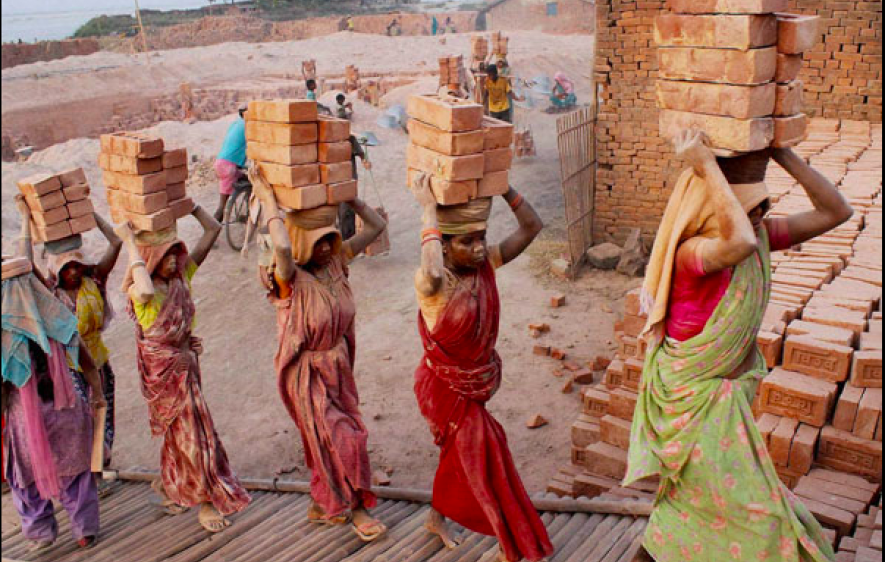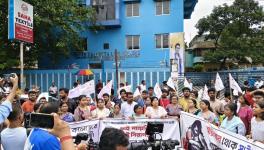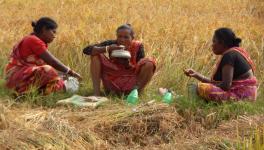Women Workers Remain Underpaid, Pvt Sector Participation Does More Harm than Good

The high participation of women farmers and agricultural workers in recently concluded AIDWA and mazdoor-kisan (workers-farmers) rallies shows that the neoliberal policy-driven structural changes in the rural economy have had a devastating impact on the lives of women and their families. These changes are driven by a sharp decrease in public investment in employment generation activities and policies that open up rural markets to big businesses. One such flagship mission is the National Rural Livelihood Mission whose main focus is to support the start-up enterprises and integrate them with commodity supply chains by enhancing their skills, and helping in value chain development. One sub-set of this scheme is the Mahila Kisan Sashaktikaran Mission, which works through women’s self help groups, and provides training to them for starting enterprises in sustainable agriculture, lac and tassar, and collection of non-timber forest produce. A substantial amount of this scheme is also allocated to the development of value chains for the products in which the women were to be trained, and linked to private sector-dominated commodity supply chains. The total allocation in this scheme is about Rs 2,875 crore which works out to about Rs 572 per woman farmer and about Rs 5,715.40 per self help group. This means that the women under NRLM are at the mercy of private investors if they are to make their livelihoods sustainable; therefore integrating these groups into commodity supply chains. Though this process may have begun in India about a decade and a half back, the experiences from trends from the rest of the world show the impact of the integration of the Global South into commodity chains on women and small farmers. The conclusions of such studies provide important lessons for understanding the implications of the government of India’s design of the National Rural Livelihood Mission.
Small farmers and global supply chains
A recent study of 15 commodity chains by Oxfam (2018) in 15 different countries from Latin America, Asia and Africa shows that the market for agricultural produce is largely controlled by a few cartels. For example, three conglomerates controlled most of the production of inputs and chemicals; 70 per cent of corn, wheat and soya retail is controlled by four companies and 10 supermarkets control more than 50 per cent of the food retail trade. This control of forward and backward linkages has made a majority of the small farmers in these countries dependent on big players for their survival. Hence, the maximum number of farms in supply chains are family farms with very small landholdings. These small-scale holdings are at disadvantage especially when export prices decline. The study shows that there has been a secular decline in export prices of orange juice in Brazil and green beans in Kenya from the mid-1980s to the mid-2000s (to the tune of 70 per cent in each of these cases), depressing the prices that the small farmers get within supply chain contracts. It is therefore not surprising that the share of supermarkets vis-à-vis the total price to the consumer has gone up from 45 per cent to 48 per cent between 1996 and 2015, irrespective of the agricultural commodity exported and irrespective of the region from which it is exported. Similarly the average share of the small farmers came down from 8 per cent to 6.5 per cent. This has led to the semi-proletarianisation of the small farmers, most of them at least partly depending on precarious labour in plantations and other non-farm casual work.
Global supply chains and their impact on women
The study also notes that the women bear a great burden of work in family farms that are networked into supply chains. For example, there is high participation of women in the tea industry of India, rice supply chains in Thailand and green beans in Kenya among others. Falling price shares of small farmers also induce more unpaid work on family farms by women and children. This means that the gap between the wages received by the workers/farmers and a living wage is high on farms with high women and child labour, thus jeopardising the food security of the family. For example, women surveyed in the grape farms of South Africa said that they did not have enough to feed their families in the previous month and at least a third of them said that their families had gone to bed hungry at least once in the previous month. Similarly, about 54 per cent of the women workers in the shrimp supply chains of Thailand reported that they had no food to eat at their homes. The same was true of almost 72 per cent of the women workers in the small-scale banana farms of Philippines.
Further, even in paid employment, women are locked into contracts that get them to overwork, and do not even pay them subsistence wages. This is even true of women located in supply chains within the developed countries. For example, in Italy, women working in the fruit and vegetable picking industry get paid $ 22-30 for a 12-hour day. This wage is 30 per cent less than the wage of men doing the same job. Both men and women got less than the minimum legal wage. Further, among the practices adopted by the supermarket chain was the application of the piece-rated system which was considered illegal under the national law. Women working under the piece-rated system got $ 3-4 for picking 300 kg of tomatoes. Minimum wage practices were also violated in the shrimp industry in Thailand where most women were made to do unpaid overtime work to meet the target of peeling 15 kg of shrimp per hour. In the grape farms of South Africa, women workers reported that they were paid on piece rates and their production targets were steadily increased. Lack of meeting targets led to wage cuts, and therefore, a lot of the work done by them was in fact unpaid work. Further, the health hazards increased as at least 51 per cent of the women workers were exposed to pesticides, thus resulting in long term impact on health.
Any discussion of the structural changes within the rural economy and arguments for public private partnerships should be seen in the light of the above mentioned facts. This wide-ranging study makes it clear that global supply chains are not going to pursue any altruistic policies to reduce their profits and provide safety nets for workers in informal employment. Rather these unfair practices are a result of a systemic necessity of global supply retail chains whose main objective is to maintain and expand their wealth through the domination of the market. Thus, the government of India’s thrust towards private sector participation in their flagship rural livelihood programme should be resolutely opposed.
Get the latest reports & analysis with people's perspective on Protests, movements & deep analytical videos, discussions of the current affairs in your Telegram app. Subscribe to NewsClick's Telegram channel & get Real-Time updates on stories, as they get published on our website.
























